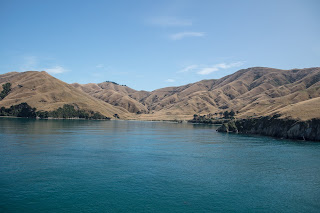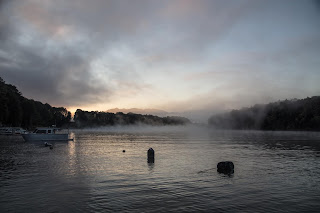Postcards from Australasia #22
From Invercargill we got the ferry across to Oban on Stewart Island and settled in to our motel room. Soon there was a tapping on the window, this South Island Kaka was obviously used to getting treats from the guests, it bit my finger too at one point, cheeky so-and-so:
The next day we stayed in, taking a break from our travels and watching the rain out of the window. The following day we did a walk taking in some of the trails, although we had to wait for the rain to properly clear off. On our third and final day on Stewart we got the water taxi across to Ulva Island/Rakiura, enjoying a close encounter with this White-capped Albatross on the way:
Because of the on and off rain i didn't take my telephoto instread relying on a normal lens, so i focused on some other forms of life on one of the beaches we visited on the circular trail:
We did see Stewart Island Robin, a sub-species of South Island Robin, critically engangered and in fact extinct on Stewart Island itself:
We also found something that looks suspiciously like a Fly Agaric:
Heading back over the hill having returned to the main Island, a Kereru/New Zealand Wood Pigeon was browsing on the grass of a sports field:
Our final morning on the island was marked by a beautiful sunrise:
Then it was down to the ferry terminal for the one hour crossing of the infamous Fevaux Straight, again as flat as a pancake:
Although another weather front was moving across the sky in front of us:
From Stewart we drove via the Catlins toward our next desintation, Owaka. This is a typical beach on that area of the coast:
We stopped to explore some of the waterfalles including this, Macleans:
And taking in some vistas, which proved glorious:
We spent a day exploring the Owaka area, passing by estuaries:
Farms, this sheep seemed very happy with the Autumn sunshine:
We walked a few trails, exploring beaches, etc., looking for the Yellow-eyed Penguin, no joy though, we picked the wrong time of day and indeed the wrong season, but plenty of things still caught the eye:
A Red-billed Gull had found something, i think it may be a hunk of bread but can't be sure:
More waterfalls, it's a lovely area to explore:
From Owaka we headed up to Dunedin just a few weeks short of our planned flight home. However the news of the UK government's experiment with herd immunity (i.e. mass infection and mass deaths), the chaos of border closures and the risks involved in international travel we had to really start thinking about what we were going to do.
We still went out and explored, visiting Cape Saunders, Helen's family name connection again:
It's a very remote cape and headland and mostly farms and private land, but Helen gamely posed by the sign to prove we'd visited. That night we raised a glass of port to her late Father as we'd promised to do.
Then we headed to a beach, again no Penguins but we did see New Zealand Sealions hauling out and settling down to sleep. I think the sand is to proect them from the prolific biting insects present all over South Island:
They soon settled:
We stopped by a small estuary to watch the tide slowly go out and the various birds there including White-faced Heron, South Island Oystercathers and this New Zealand (Sacred) Kingfisher all feeding in the shallows, when not perched and watching:
We finally visited the Orokonui Sanctuary. A quieter than usual inland bird sanctuary, the numbers of tourists now visibly falling as new border restrictions were put in place. With confirmed infections above 20 you could feel the change in atmosphere. We enjoyed a sunshine walk, keeping our distance from fellow visitors, though really enjoying the wildlife including this Bellbird:
And the New Zealand Fantail amongst many others:
The mood music however with infections picking up across New Zealand, the UK and USA in full basket-case mode, Italy and Spain in crisis and with plenty of tourists still around (particularly from the USA which appreas to have no idea of the scale of the infection hence they are spreading it far and wide on their travels), lots of changes to border policies, airlines shutting down, etc., we decided the best course of action was to try and stay in New Zealand, rent a small place off the beaten track and try and weather the storm.
This therefore brought to an early end our holiday of a lifteime and what a holiday it has been! Since the start of 2019 we've seen roughly 1,000 species of bird, travelled extensively in Australia, Fiji, PNG and finally New Zealand. We've met some lovely people, caught up with friends, seen some amazing places, been harried by snakes, chased by spiders, been in front-of and behind catastrophic bushfires and now it's time to rest, take stock and try and avoid the virus that is doing so much harm to so many...
On our way to our self-imposed isolation we stopped at a few beaches but it felt time to get a move on so we did:
























































